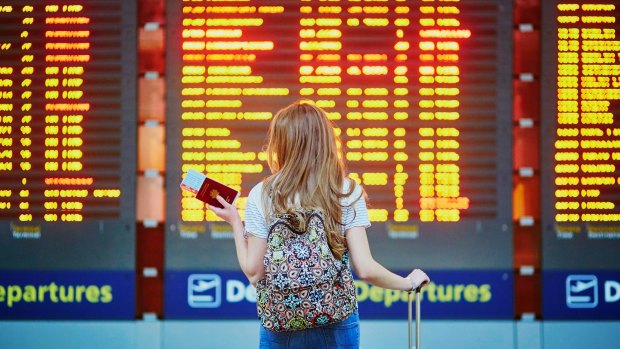This was published 1 year ago
Why so many flights are being delayed or cancelled
By Michael Gebicki

Flight delays and cancellations have soared in 2022.Credit: iStock
The northern summer of 2022 was the first major post-pandemic stress test for the aviation industry, and it was chaotic. Airports reported queues never seen before. Flight delays and cancellations blew out, causing travellers to miss cruises, tours they'd booked months before, weddings and other major family events.
On one day in July, airports around the world notched up more than 25,000 flight delays and 3100 cancellations, according to FlightAware.com's live flight tracking data. FlightAware has been publishing an online Misery Map for major domestic airports across the USA, showing where the most delays and cancellations are happening in real time.
In Australia, the mess was echoed in the mid-year school holidays. In one week in July, just 44 per cent of Qantas' flights were on time and flight cancellations approached seven per cent. Virgin Australia's flight cancellations for the same week were close to 15 per cent, with delays to more than half of all the airline's flights.
Attempting to triage the turmoil and passengers' outrage, airlines responded by amputating services. British Airways slashed its summer flight schedule by 13 per cent, followed by a reduction of 10,000 fewer flights from late October 2022 to March 2023. For a brief time, BA banned ticket sales for departures from London's Heathrow, its main base, when the airport instituted a daily departure cap of 100,000 passengers. That cap lasted from July to October, in response to airport staffing shortages in the areas of security, ground staff and baggage handling. In the USA, starting from July 1, 2022, United shucked 50 departures per day from its Newark Airport hub. JetBlue had already cut its summer schedule by 10 per cent while Southwest Airlines took the razor to 8000 flights scheduled for June 2022.
Why the great layoff caused comeback chaos
As a result of the pandemic and the consequent lockdowns and lock-ins, the aviation industry slumped. According to a parliamentary hearing into the future of Australia's aviation sector, at the peak of the crisis, airline passenger traffic in Australia fell by around 97 per cent from pre-pandemic levels. Airlines downsized massively, mothballing aircraft and shaking off staff like a golden retriever after a dip. More than 30,000 aviation workers were stood down or laid off. That's about 30 per cent of Australia's aviation workforce according to Scott McDine, head of the Sydney office of the International Transport Workers' Federation.
After they were stood down most of those workers found employment somewhere else, anything from working in cyber security to hospitality to driving COVID samples to labs for PCR tests. Many were long-term employees, including baby-boomer pilots who were nearing compulsory retirement age when the pandemic struck. Some were offered redundancy packages, which they grabbed. Those pilots feature heavily among the ranks of senior captains.
When the restrictions were loosened and the aviation industry began to get back of its feet, those bits were missing. There were staff shortages right across the spectrum, from baggage handlers to check captains. Even for pilots willing and able to return to work, many were no longer qualified. Pilots have to undergo regular testing to maintain their certification. That didn't happen during the pandemic, and there are only so many flight simulators capable of assessing pilots to the rigorous standards required.
Supply chain bottlenecks
The same supply chain bottlenecks that have interrupted the production of new cars and building supplies have also left airlines struggling with aircraft out of action, and causing delays, cancellations and grounded aircraft. As well as a shortage of qualified engineers, airlines are having to wait longer for engine components that need replacing. Aircraft that were mothballed during the pandemic need to be returned to service, and that involves maintenance checks, which can lead to competition for hangar space with in-service aircraft with their own maintenance requirements.
Airlines typically describe these events as technical or engineering issues, and they don't always happen at the last moment. Aircraft go offline for programmed maintenance and the airline will schedule those weeks in advance, but long after airline schedules are announced, and bookings made. Given the current aircraft and staffing issues, there might be no replacement aircraft available, and so a cancellation or delay is the only option. "A technical issue" is one of the fallbacks for airlines when they need to communicate a service delay or cancellation to passengers. What passenger is going to argue with that?
See also: Despite being an expert traveller, I still got scammed in Italy
See also: Are Australians being ripped off on airfares? What the numbers show
Sign up for the Traveller newsletter
The latest travel news, tips and inspiration delivered to your inbox. Sign up now.